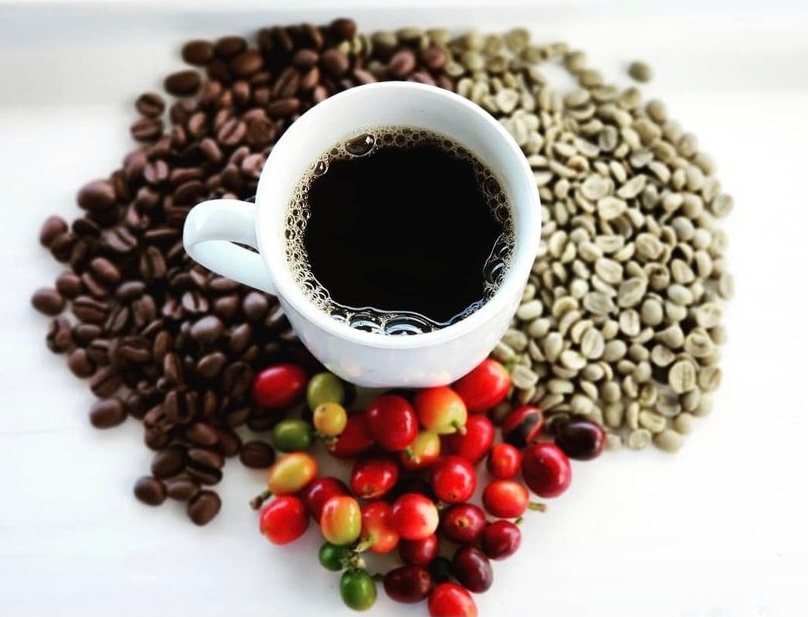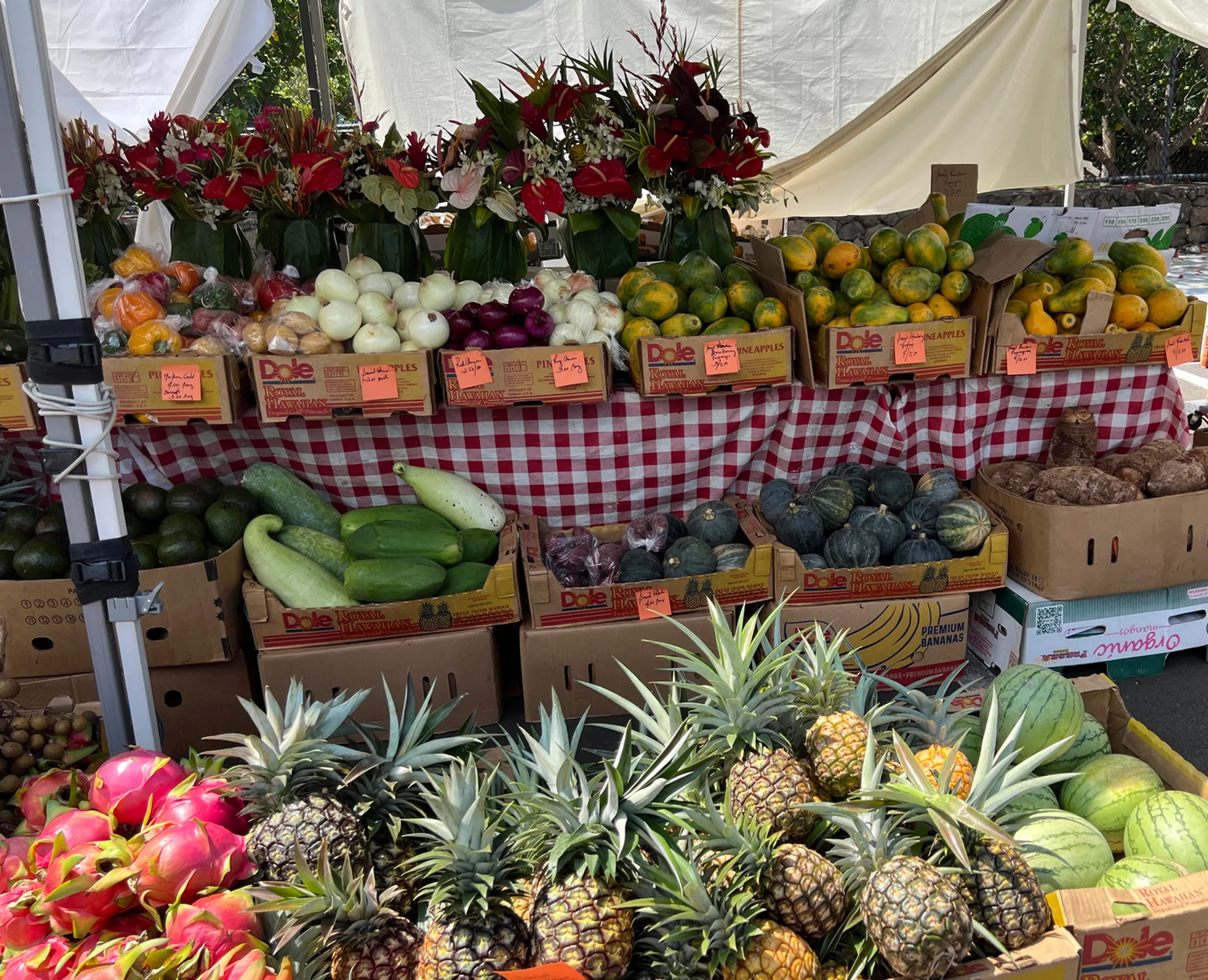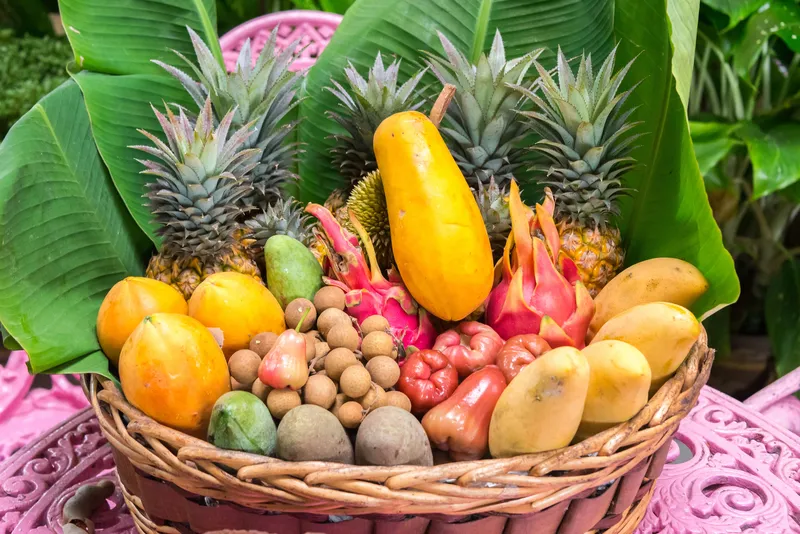
“Brew Your Best Cup”- Coffee Brewing Workshop
Heavenly Hawaiian Coffee Farm • Farm • Holualoa, Island of Hawaii • Hawaii

A taste of the islands: Discover exotic fruits and vegetables grown in paradise

Written by a Local Market Expert
Kalani MillerFor me, half the fun of visiting a farmers' market in Hawaiʻi is discovering fruits and vegetables that look like they came from another planet. That spiky red ball? It's a rambutan. That giant green thing that looks like a brain? That's ʻulu, or breadfruit. Don't be intimidated!
Hawaiian farmers' markets are windows into the islands' incredible biodiversity and cultural fusion. Where else can you find Japanese persimmons growing next to native ʻulu (breadfruit), or taste Korean kim chi made with local vegetables?
| Fruit/Vegetable | Peak Season | Year-Round? |
|---|---|---|
| Mango | May - October | No |
| Lilikoi (Passion Fruit) | Summer/Fall | Yes |
| Lychee | May - August | No |
| ʻUlu (Breadfruit) | Year-Round | Yes |
| Dragon Fruit | Summer/Fall | No |
What it looks like: You'll know lilikoi by its wrinkly yellow or purple skin and incredibly fragrant, tangy, and sweet pulp inside. It's the flavor of the islands.
How to eat it: Just cut it in half and scoop out the pulp with a spoon. The seeds are edible and add a nice crunch.
Local uses: Locals use it for everything: juice, jam, butter, cocktails, and drizzled over shave ice. It's incredibly versatile and absolutely delicious.

Cultural significance: This is one of the most important "canoe plants" that ancient Polynesians brought to Hawaiʻi. It's a starchy staple that, when mature, has a texture and flavor similar to a potato.
How to prepare: It can be roasted, fried into chips, steamed, or mashed. Unripe ʻulu can be boiled and tastes like an artichoke heart, while very ripe ʻulu is sweet and can be used in desserts.
Where to find: Look for the large, green, brain-textured fruit at most Hawaiian markets.
Peak season magic: Mango season (roughly May through October) is a near-religious event in Hawaiʻi. Forget the stringy mangoes you get on the mainland; our local varieties like Pirie, Haden, and Rapoza are creamy, sweet, and non-fibrous.
Insider tip: Look for mangoes that give slightly to pressure and have a sweet aroma at the stem end. Don't judge by color alone - some of the best varieties remain green when ripe.
How to tell them apart: These two are cousins and are often sold side-by-side in the summer. Lychee has a bumpy red shell, while rambutan looks like a furry red sea urchin.
How to enjoy: To eat them, just peel back the skin to reveal a sweet, juicy, grape-like fruit inside. They are incredibly refreshing on a hot day and have a floral, sweet flavor.
Smaller, sweeter, tangier
White-fleshed, incredibly sweet
Perfect for eating raw
What to expect: Another canoe plant, this beautiful, bell-shaped fruit has shiny red skin and crisp, juicy white flesh. The flavor is mild, slightly tart, and has a delicate scent of roses.
Handling tip: They bruise easily, so handle them with care. Peak season is June through October.
Cultural importance: Kalo is the most culturally significant plant in Hawaiʻi. The starchy root (corm) is steamed and pounded to make poi, a cornerstone of the traditional Hawaiian diet.
Uses: The heart-shaped leaves, called lūʻau leaves, are also edible but must be cooked thoroughly. They are used to wrap pork for laulau or stewed with coconut milk.
Visual appeal: This stunning fruit looks like something from a fantasy novel with its bright pink skin and green scales. Inside, the flesh is white or pink with tiny black seeds.
Taste: The flavor is mild and refreshing, similar to a kiwi but less tart. It's perfect for smoothies, fruit salads, or eating fresh.
Pro Tip: Don't be afraid to ask vendors for samples or advice on how to eat unfamiliar fruits. Most are happy to share their knowledge and help you discover new flavors. This is part of the wonderful community spirit you'll find at Hawaiian farmers' markets.

Heavenly Hawaiian Coffee Farm • Farm • Holualoa, Island of Hawaii • Hawaii

